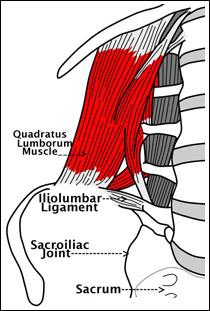There are many ligaments in the low back holding the bones together. Injury or inflammation of any of them can cause pain. The ones I’m most interested in as a Neuromuscular Therapist are the ones I can access with a positive effect: the iliolumbar and sacroiliac ligaments, and with them the lumbosacral fascia. This superficial broad fascia protects and anchors low back structures and can tear when strained. Through it, herniated fat lobules can form and produce their own TrPs.
Ligaments hold bone to bone. Tendons hold muscle to bone. Fascia permeates, covers, separates or surrounds all the structures in the body.
Ligaments function to hold a joint stable while providing slight movement to protect the bones from breaking under stress. Within the joints are nerves, but there are also nerves that record pain within the connective tissue that makes up the ligaments, tendons and fascia. If ligaments get weak, the joint becomes misaligned and can irritate or compress nerves within them.
When muscles and tendons are strained to their limit, the ligaments stiffen to protect the joint. When a joint is chronically tight it causes pain. Loosening the ligaments enough to allow normal joint flexibility restores normal function and reduces pain symptoms.
When I treat low back pain in my Neuromuscular Therapy center near Boston, I always pay attention to the iliolumbar and sacroiliac ligaments.
 The iliolumbar ligament holds the 5th lumbar vertebra to the iliac crest of the hip, taking the place of the lowest portion of the quadratus lumborum muscle. I can treat it by going very deep with a pressure bar. Sustained pressure slowly stretches and softens the ligament. Cross-fiber friction can stimulate healing.
The iliolumbar ligament holds the 5th lumbar vertebra to the iliac crest of the hip, taking the place of the lowest portion of the quadratus lumborum muscle. I can treat it by going very deep with a pressure bar. Sustained pressure slowly stretches and softens the ligament. Cross-fiber friction can stimulate healing.
The sacroiliac ligament holds the pelvis to the sacrum. Only the back part of it can be accessed because the joint goes deep and becomes thicker as it gets to the inner bowl of the pelvis. When it is inflamed the edge of the sacrum can be exquisitely tender to touch and movement difficult. Mobilization techniques can be used to rotate the joint and take the pressure off the ligament. Treatment of the muscles that cross the joint is usually effective. Muscles that refer pain from Trigger Points to the joint must also be treated to reduce painful symptoms.
Across the sacrum, covering the ligaments and tendons and some muscle fibers there is the lumbosacral fascia. There is often a fat pad underneath it. The fascia can become inflammed and very sensitive to light touch making it uncomfortable to sit back in a car seat or easy chair.
Although the fascia is pretty strong, it can develop tears when strained. Herniations can occur through which fat lobules can protrude. These fat lobules can develop their own Trigger Point referrals. Herniations can also occur along the curved crest of the hip bone where the fascia is anchored.
The next post presents a review of a typical case.